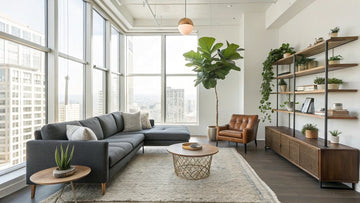Indoor plants and furniture can work together to make a cozy and welcoming lounge space. Big plants look good next to large furniture, and small plants fit nicely on tables and shelves. Putting plants in groups of three or five near seats makes the room look better and keeps walking paths clear. Using plants of different sizes and leaf types adds more depth to the room. When plants are put in the right spots, they help turn basic rooms into beautiful spaces that change as the seasons pass.
Key Takeaways
- Position tall plants behind sofas and chairs to create visual depth while maintaining a comfortable seating arrangement.
- Group plants in threes with varying heights near seating areas, keeping at least 12 inches away from walkways.
- Use side tables and shelves for smaller plants to maximize floor space and create layered visual interest.
- Place large statement plants in room corners to anchor furniture arrangements without disrupting traffic flow.
- Combine different leaf textures and plant sizes around seating areas while maintaining clear pathways for movement.
Understanding Plant and Furniture Balance
Plants and furniture need to work together to make a room look good. When placing them, it's important to make sure one doesn't overpower the other. Big plants can work well next to large furniture pieces to create interesting spots in the room that catch your attention.
To make a room feel like a beautiful indoor garden, you need to think about where you put each plant. Tall plants help pull your eyes up and work nicely with big furniture pieces, making rooms feel bigger. Small plants on tables and shelves add different levels of green without making the room feel too busy.
When you spread plants around carefully, the room stays neat while looking its best. By matching plant sizes with furniture sizes, you can create rooms that bring together nature and indoor spaces in a smooth way.
Creating Green Focal Points Around Seating
Creating Green Spots Around Seats
Plants placed around seating areas can turn basic rooms into lively, warm spaces. Putting furniture and plants in the right spots makes the room feel balanced and easy to use.
- Put tall plants behind main seats to draw the eye and make big furniture pieces look softer.
- Place medium plants on side tables and near sofa ends to make sitting areas feel cozy.
- Add hanging or creeping plants on nearby shelves to give the space more depth.
- Group three plants of different heights together - odd numbers look more natural.
Keep plant arrangements 12-18 inches away from walking paths so people can move easily around the seats.
This keeps the seating area both pretty and practical, letting everyone walk through comfortably.
Strategic Plant Placement for Traffic Flow
Strategic placement of plants helps keep walkways clear while making indoor spaces more beautiful. Placing big plants away from walking areas and small plants on higher surfaces keeps rooms easy to move through. Plants can separate different areas of a room without getting in the way.
| Location | Plant Type | Traffic Flow Impact |
|---|---|---|
| Pathways | Small, ground plants | Little blocking |
| Seating Areas | Mixed sizes in groups | Makes spaces distinct |
| High Surfaces | Hanging plants | No blocking |
In small living rooms, think about how people move when placing plants. Put plants in groups of odd numbers near seats to look good while keeping paths open. Using hanging plants and high shelves saves floor space, making it easy to walk around the room. For additional space-saving solutions for lounges, consider multifunctional furniture pieces.
Layering Heights and Textures With Plants
Plants look better when arranged in layers with different heights and textures. A good way to group plants is to put them in sets of three, mixing tall plants with smaller ones that sit on tables.
Using plants with different looks - like smooth-leafed plants next to ones with rough or feathery leaves - makes the display more interesting.
- Put big floor plants in the back, with shorter ones in front
- Choose plants with different leaf types to tell them apart easily
- Mix straight-growing plants with ones that hang or drape
- Pick plain pots that let the plants stand out but still look good together
When plants are set up at different heights and have different textures and shapes, they make rooms more lively and give your eyes interesting things to look at from floor to ceiling. Consider incorporating contemporary shelving solutions to display your plants at varying heights.
Window Areas and Natural Light Optimization
Natural light from windows is key to placing indoor plants correctly. Putting plants in the right spots near windows helps them grow well and creates healthy indoor spaces. Plants that love sun do best in direct light, while plants that prefer shade need softer light through thin curtains.
| Light Level | Plant Type | Window Position |
|---|---|---|
| Direct Sun | Succulents | South-facing |
| Partial Sun | Peace Lily | East/West-facing |
| Low Light | Ferns | North-facing |
The best spots for plants change with the seasons as light gets stronger or weaker and days get longer or shorter. Window sills work great for small plants, making them easy to care for while giving them plenty of light. Check your plants throughout the year and move them if needed to keep them from getting too much or too little light. When leaves burn or plants grow poorly, it's often because they're in the wrong spot. Taking time to put plants in the right places keeps them healthy and makes your space look good.
Plant Groupings for Different Furniture Zones
Plants and furniture work together to create useful spaces in your home. Good plant placement helps rooms look better while making the best use of available space.
- Big plants like fiddle leaf figs work well in corners next to large furniture pieces.
- Small and hanging plants fit nicely on coffee tables and side tables without getting in the way.
- Medium-sized plants make perfect centerpieces for dining tables and add natural beauty to meals.
- Plants placed near chairs and sofas turn basic sitting areas into cozy green spaces.
Putting furniture and plants in the right spots ensures enough room between them. This lets people see and enjoy each plant while moving easily through the room. Understanding proper lounge furniture arrangement helps create optimal plant placement opportunities.
The result is a balanced space where nature and furniture blend together in an appealing way.
Small Space Solutions With Vertical Greenery
Plants can grow upward to save space in small rooms in three helpful ways.
First, plants that hang from above use ceiling space instead of floor space, creating a beautiful look with leaves that droop down. Second, plants attached to walls turn empty wall space into living green displays that clean the air while taking up no floor room. To make the most of small spaces, mix these methods with a few well-placed plant stands to create different levels of greenery. Plants like Pothos that grow downward from high spots work well with wall gardens, which look like living pictures.
This way of placing plants at different heights turns tight spaces into green, fresh-feeling rooms that are still easy to use.
Seasonal Plant Rotation and Furniture Adaptations
Smart placement of plants indoors means changing their spots as seasons change. By moving both plants and furniture, you can help plants get the light they need and grow well all year round.
- Easy-to-move furniture helps create spaces that work for plants while keeping rooms looking nice.
- Moving plants to catch more sunlight in winter helps them stay healthy when days are shorter.
- Adding seasonal items near plants makes rooms look fresh as plants change through the year.
- Placing furniture in the right spots helps air move better around plants.
Using light furniture that's easy to move makes it simple to change room setups as needed. This way of arranging both plants and furniture helps plants grow better and creates rooms that look different and fresh as nature changes through the year. Learn more about creating zones in open-plan areas for flexible seasonal arrangements.
Frequently Asked Questions
Where Is the Best Place to Put Plants in the Living Room?
Thoughtful plant placement works best when you match plant size and sunlight needs. Put tall plants in room corners, medium-sized ones on tables or shelves, and small plants near windows. For a pleasing look, arrange plants in groups of three or five while keeping the room easy to move around in.
Where to Place Plants in a Living Room According to Feng Shui?
Plants work best in the money area (back left corner when you enter the room), and they should be placed in groups of three or five. Put plants with round leaves away from doors and windows, making sure there's enough space around them and good sunlight to help positive energy move freely.
Where Should Indoor Plants Be Placed?
Plants inside your home need the right spots based on how much light they like, how tall they grow, and how much water they need. Put plants of different sizes in pots that fit them well, and group them in ways that look good together. Mix different kinds of plants around your rooms to help clean the air and add nice splashes of color.
What Direction Should Indoor Plants Face?
Indoor plants grow best when they face the sun or bright areas in your home. Most plants will lean toward light, so place them where they can get enough sunshine based on what each plant needs. You'll want to turn your plants now and then to help them grow evenly, and make sure they have enough space for fresh air to move around them. Some plants like lots of sun, while others do better with less direct light, so check what works for your specific plants and adjust their spots as seasons change.
Conclusion
Indoor plants paired with beautifully crafted Timbur furniture creates living spaces that blend natural elements with functional design. By understanding light needs, movement patterns, and furniture zones, you can create welcoming arrangements that bring out the best in your lounge. Whether using wall-mounted greenery or grouped plant displays, these natural touches transform basic rooms into fresh, dynamic spaces that change with the seasons while keeping comfort and style in perfect balance. The rich wooden tones of Timbur pieces complement indoor plants perfectly, creating a harmonious mix of crafted and natural elements in your home. Consider exploring multifunctional furniture for flexible spaces to maximize both plant placement and room functionality.









